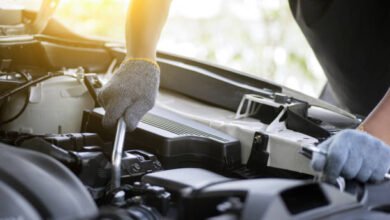Automatic Transmission Slipping: Causes, Diagnosis, and Solutions

Table of Contents
ToggleIntroduction
Automatic transmissions are a marvel of modern automotive engineering, providing smooth and effortless gear changes that enhance driving comfort and efficiency. These systems automatically change the gear ratios as the vehicle moves, freeing the driver from having to shift gears manually. However, like all mechanical systems, automatic transmissions can experience issues over time due to wear and tear, lack of maintenance, or other factors. One common problem drivers may encounter is transmission slipping, which can significantly impact vehicle performance and safety. This article explores what automatic transmission slipping is, its causes, how to diagnose it, and the best solutions to keep your vehicle running smoothly.
What is Transmission Slipping?
Automatic transmission slipping occurs when the transmission fails to engage properly, causing a loss of power transfer from the engine to the wheels. When this happens, the vehicle might not accelerate as expected, leading to a noticeable drop in performance. Symptoms of transmission slipping include unusual noises such as grinding, whining, or humming during shifting, which can indicate internal component wear or damage. Drivers may also experience delayed or rough shifting, where the gear changes are not smooth or occur with a noticeable lag. Another common sign is RPM spikes without a corresponding increase in speed, where the engine revs higher than usual but the vehicle does not accelerate accordingly. Additionally, a burnt transmission fluid smell can indicate overheating or degradation of the fluid, which is critical for the transmission’s operation.
Causes of Transmission Slipping?
Automatic transmission slipping can result from various issues. Low or insufficient transmission fluid is a common cause, as the fluid is crucial for lubrication, cooling, and hydraulic pressure. Without adequate fluid, the transmission cannot function properly, leading to slipping and potential damage. Worn or damaged transmission bands, which are essential for holding the gears in place, can also cause slipping. These bands can wear out over time due to excessive use, overheating, or lack of maintenance. Malfunctioning solenoids, which control the flow of transmission fluid and hydraulic pressure, can lead to improper gear engagement and slipping. Worn-out clutches, which are responsible for engaging and disengaging the gears, can also result in slipping when they lose their ability to hold power. Torque converter issues, such as a malfunctioning or damaged torque converter, can cause the transmission to slip as well. Finally, general wear and tear due to high mileage or age can degrade various transmission components, leading to slipping and other performance issues.
Diagnosing Transmission Slipping
Diagnosing transmission slipping requires a professional approach to accurately identify the underlying cause. One of the first steps in diagnosis is checking the transmission fluid level and condition. Low fluid levels or dirty, burnt fluid can indicate potential problems. Reading diagnostic trouble codes (DTCs) using a scan tool can provide valuable information about specific issues within the transmission system. These codes help pinpoint malfunctioning components such as solenoids, sensors, or clutches. Visual inspections of the transmission and related components can reveal signs of wear, damage, or leaks. Road testing the vehicle allows mechanics to observe the transmission’s behavior under various driving conditions, helping to identify symptoms like delayed shifting, slipping, or unusual noises. Early detection through thorough diagnosis is crucial in preventing more severe damage and costly repairs.
Preventive Maintenance
Regular preventive maintenance can significantly reduce the risk of transmission slipping and extend the lifespan of the transmission. This includes changing the transmission fluid at recommended intervals, which varies depending on the vehicle make, model, and driving conditions. Using the correct type of fluid specified by the manufacturer is essential for optimal performance. Periodic inspections of the transmission system can identify potential issues before they become major problems. This includes checking for fluid leaks, inspecting the condition of the transmission bands and clutches, and ensuring that solenoids and sensors are functioning correctly. Addressing minor issues promptly can prevent them from escalating into more severe problems that require expensive repairs. Additionally, following the manufacturer’s maintenance schedule and avoiding aggressive driving habits can help keep the transmission in good condition.
Repair and Solutions
Repairing an automatic transmission slipping can involve various approaches depending on the specific cause and severity of the issue. A fluid top-up or flush may be necessary if the transmission fluid is low or degraded. This involves draining the old fluid, cleaning the system, and refilling it with fresh fluid. Replacing worn components such as transmission bands, clutches, and solenoids may be required to restore proper function. If the torque converter is the source of the problem, it may need to be repaired or replaced. In some cases, a complete transmission rebuild or replacement might be considered, especially if multiple components are damaged or the transmission has high mileage. This involves disassembling the transmission, inspecting and replacing worn parts, and reassembling it to restore factory performance. The choice between repair and replacement depends on factors such as the extent of the damage, cost considerations, and the overall condition of the vehicle.
Costs Involved
The costs involved in repairing a slipping transmission can vary widely depending on the specific repairs needed and the vehicle’s make and model. Simple fluid changes and minor repairs are relatively inexpensive, typically ranging from $100 to $300. Replacing worn components such as transmission bands, clutches, or solenoids can cost between $300 and $1,000, depending on the parts and labor required. Repairing or replacing the torque converter can be more expensive, with costs ranging from $600 to $2,000. A complete transmission rebuild or replacement is the most costly option, with prices ranging from $1,500 to $4,000 or more, depending on the vehicle and the extent of the work needed. Factors affecting repair costs include the availability and cost of parts, the complexity of the repairs, and the labor rates charged by the repair shop. It’s important to get multiple quotes and consider the long-term value of the repairs before making a decision.
Conclusion
Addressing transmission slipping promptly is crucial for maintaining vehicle performance and preventing further damage. Regular maintenance and early diagnosis can save time and money by preventing minor issues from becoming major problems. If you suspect your transmission is slipping, seek professional help to ensure your vehicle remains in top condition. A well-maintained transmission not only enhances driving comfort and efficiency but also contributes to the overall safety and reliability of your vehicle.
Additional Resources
For further reading and professional assistance, consider consulting additional resources such as automotive repair manuals, online forums, and articles on transmission maintenance and repair. Contacting qualified mechanics or transmission specialists can provide expert advice and services tailored to your vehicle’s needs. Proper care and maintenance of your vehicle’s transmission can ensure a smooth and reliable driving experience for years to come.





My fascination with your creations is on par with your own. The sketch you’ve presented is tasteful, and the content you’ve authored is of a high caliber. Nevertheless, you seem uneasy about the prospect of embarking on something that could be perceived as dubious. I believe you’ll be able to resolve this concern in a timely manner.